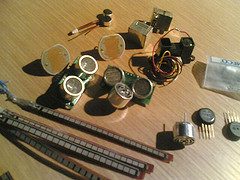

Two families of pattern recognition receptors have been shown to distinguish unique molecules present in pathogens, such as bacterial and fungal cell wall components, viral RNA and DNA, and lipoproteins. The first family includes the membrane-bound toll-like receptors (TLRs). A second family of pattern recognition receptors has recently been identified, which comprises the cytoplasmic sensors of viral nucleic acids, including MDA-5, RIG-I, and LGP2. Studies of the signaling pathways that lead from pattern recognition to cytokine induction have revealed extensive and overlapping cascades that involve protein-protein interactions and phosphorylation, and culminate in activation of transcription proteins that control the transcription of genes encoding interferons and other cytokines.
A relatively uncharted area of innate immunity is the recognition of viral DNA. There have been several reports of cytoplasmic DNA sensors, but precisely how these recognize nucleic acid and induce cytokine synthesis remains to be determined. When double-stranded DNA is introduced into the cell cytoplasm, production of type I interferons and chemokines occurs independently of Toll-like receptors and the cytoplasmic RNA sensor RIG-I. dsDNA activates transcription factor IRF3 and the interferon-beta promoter through a signaling pathway involving the kinases TBK1 and IKKi. Transcription factor NF-kappaB is also activated after introduction of dsDNA, independent of TBK and IKKi, but dependent upon IPS-1, an adaptor molecule that links RIG-I with downstream signaling events.
Another putative DNA sensor is DLM-1 , or DAI (DNA-dependent activator of IFN-regulatory factors). Synthesis of DAI in cells enhances DNA-mediated induction of type I IFN, while silencing of mRNA for DAI inhibits this response. DAI also binds to dsDNA and enhances its association with IRF3 and TBK1.
Recently a new DNA sensor, AIM2 (absent in melanoma 2), was identified by a proteomics screen for proteins that bind DNA and are induced by interferon-beta. The protein was found to localize to the cell cytoplasm and binds dsDNA, consistent with a role in sensing DNA. AIM2 was found to be part of the inflammasome, a multiprotein complex involved in inducing synthesis of pro-inflammatory cytokines. Levels of AIM2 rose significantly in cells treated with dsDNA, and siRNA mediated silencing of its mRNA interfered with secretion of the cytokine IL-1beta.
These results certainly indicate that AIM2 is a candidate sensor of DNA. It will be of interest to determine the role of this protein in the innate response to infection with viruses that produce dsDNA.
Tilmann Bürckstümmer, Christoph Baumann, Stephan Blüml, Evelyn Dixit, Gerhard Dürnberger, Hannah Jahn, Melanie Planyavsky, Martin Bilban, Jacques Colinge, Keiryn L Bennett, Giulio Superti-Furga (2009). An orthogonal proteomic-genomic screen identifies AIM2 as a cytoplasmic DNA sensor for the inflammasome Nature Immunology DOI: 10.1038/ni.1702
Hornung V, Ablasser A, Charrel-Dennis M, Bauernfeind F, Horvath G, Caffrey DR, Latz E, & Fitzgerald KA (2009). AIM2 recognizes cytosolic dsDNA and forms a caspase-1-activating inflammasome with ASC. Nature, 458 (7237), 514-8 PMID: 19158675
Akinori Takaoka, ZhiChao Wang, Myoung Kwon Choi, Hideyuki Yanai, Hideo Negishi, Tatsuma Ban, Yan Lu, Makoto Miyagishi, Tatsuhiko Kodama, Kenya Honda, Yusuke Ohba, Tadatsugu Taniguchi (2007). DAI (DLM-1/ZBP1) is a cytosolic DNA sensor and an activator of innate immune response Nature, 448 (7152), 501-505 DOI: 10.1038/nature06013
Ken J Ishii, Cevayir Coban, Hiroki Kato, Ken Takahashi, Yuichi Torii, Fumihiko Takeshita, Holger Ludwig, Gerd Sutter, Koichi Suzuki, Hiroaki Hemmi, Shintaro Sato, Masahiro Yamamoto, Satoshi Uematsu, Taro Kawai, Osamu Takeuchi, Shizuo Akira (2005). A Toll-like receptor€“independent antiviral response induced by double-stranded B-form DNA Nature Immunology, 7 (1), 40-48 DOI: 10.1038/ni1282
D STETSON, R MEDZHITOV (2006). Recognition of Cytosolic DNA Activates an IRF3-Dependent Innate Immune Response Immunity, 24 (1), 93-103 DOI: 10.1016/j.immuni.2005.12.003
Z. Wang, M. K. Choi, T. Ban, H. Yanai, H. Negishi, Y. Lu, T. Tamura, A. Takaoka, K. Nishikura, T. Taniguchi (2008). Regulation of innate immune responses by DAI (DLM-1/ZBP1) and other DNA-sensing molecules Proceedings of the National Academy of Sciences, 105 (14), 5477-5482 DOI: 10.1073/pnas.0801295105

An excellent point. I can think of a few possibilities. One is that
these are not the sensors for DNA viruses. Another is that there might
be some leakage of DNA into the cytoplasm, either during entry or
exit. No one has yet done the experiment of silencing the DNA sensor
and seeing the effect on innate responses to DNA virus infection.
excellent posting, cheer!!!!
Poxviruses DNA repliication occurs in the cytoplasm. Also lysosomal rupture during the escape of intracellular pathogenic bacteria, such as Listeria, causes the release of undigested bacterial DNA into the cytoplasm.
You failed to cite these papers:
Fernandes-Alnemri T, Yu JW, Datta P, Wu J, Alnemri ES. (2009) AIM2 activates the inflammasome and cell death in response to cytoplasmic DNA. Nature. 2009 Jan 21. [Epub ahead of print]
Roberts TL, Idris A, Dunn JA, Kelly GM, Burnton CM, Hodgson S, Hardy LL, Garceau V, Sweet MJ, Ross IL, Hume DA, Stacey KJ. (2009) HIN-200 proteins regulate caspase activation in response to foreign cytoplasmic DNA. Science. 2009 Feb 20;323(5917):1057-60. Epub 2009 Jan 8.
Poxviruses DNA repliication occurs in the cytoplasm. Also lysosomal rupture during the escape of intracellular pathogenic bacteria, such as Listeria, causes the release of undigested bacterial DNA into the cytoplasm.
You failed to cite these papers:
Fernandes-Alnemri T, Yu JW, Datta P, Wu J, Alnemri ES. (2009) AIM2 activates the inflammasome and cell death in response to cytoplasmic DNA. Nature. 2009 Jan 21. [Epub ahead of print]
Roberts TL, Idris A, Dunn JA, Kelly GM, Burnton CM, Hodgson S, Hardy LL, Garceau V, Sweet MJ, Ross IL, Hume DA, Stacey KJ. (2009) HIN-200 proteins regulate caspase activation in response to foreign cytoplasmic DNA. Science. 2009 Feb 20;323(5917):1057-60. Epub 2009 Jan 8.
The only important expt that support the role of HIN-200 is the RNAi data, which are not impressive.